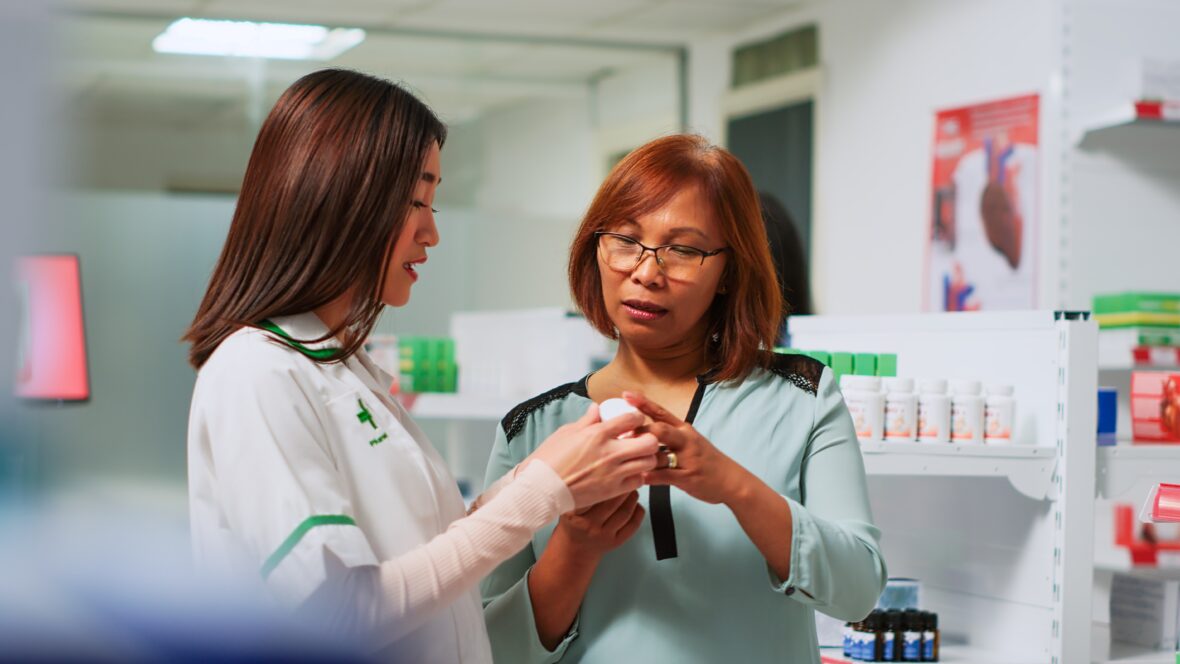Revolutionizing Healthcare: Enhancing Patient-Centered Care in Pharmacies
In today’s dynamic healthcare landscape, the role of pharmacies in delivering patient-centered care has never been more important. The marketplace has a growing number of direct-to-consumer options as individuals increasingly seek comprehensive and personalized healthcare experiences. Pharmacies stand at the intersection of medical expertise and community accessibility that poises them to capitalize on consumer needs and wants.
But what is patient-centered care? And why is it important that your pharmacy y be taking steps to stay at the forefront of cutting-edge healthcare?
In this guide, we’ll provide a definition of patient-centered care, review the importance of adopting a patient-centered care model, and outline some ways pharmacies can improve their approach.
What is Patient-Centered Care?
Historically, most types of patient care in the healthcare system have gravitated toward provider-centric models, where patients were seen as passive recipients of medical decisions. The patient-centered care model flips that narrative on its head by placing the individual at the heart of the treatment process and prioritizing value-based care.
This approach represents a significant shift in thinking. It places considerable emphasis on understanding each patient’s unique needs, values, and preferences, (and budget!) with the ultimate goal of fostering compassionate partnerships between healthcare providers, patients, and their families.
Patient-centered care is collaborative and coordinated, with patients and their families playing key decision-making roles alongside their healthcare providers to ensure emotional well-being and physical comfort in addition to meeting targeted treatment needs. According to the National Library of Medicine, patient-centered care is associated with decreased healthcare utilization of up to 31%.
Why is Patient-Centered Care Important?
Ultimately, caring for patients based on their individual needs sets higher standards for healthcare services, driving better patient outcomes and improved overall healthcare quality. Benefits of patient-centered care in a pharmacy setting include:
- Improved treatment adherence
- Increased patient empowerment and satisfaction
- Continuous improvement via patient feedback
However, patient-centered care is equally as important from a consumer perspective. Benefits of patient-centered care from a customer standpoint include:
- Easier access to care
- Enhanced ability to make informed decisions
- Access to emotional and financial support
However, given the increased ability of patients to determine the course of their own healthcare journeys in a patient-centered care model, it is essential they have a complete and detailed understanding of the procedures and treatments they will undergo.
“In order to successfully move towards delivering person-centered practice, it is imperative to equip healthcare providers with person-centered values and beliefs, while at the same time transforming current work culture to align with person-centered care.” Source: BMC Health Services Research
With that in mind, let’s examine some of the ways your pharmacy can improve on current standards.
How Pharmacies Can Improve Patient-Centered Care
Giving every patient a voice and ensuring active participation in decision-making makes it possible to transform the landscape of pharmacy services and set new standards for patient well-being and satisfaction. But every pharmacy is different. So, what is patient-centered care with regard to your specific business and client base? And how do you go about improving service quality? Here are some examples of patient-centered care strategies.
Develop Relationships with Patients
Building strong patient relationships is critical in improving medication adherence, developing a loyal patient network, and creating new business through referrals and recommendations. When pharmacists take the time to understand patients on a personal level, it fosters trust and demonstrates commitment and dedication to well-being beyond transactional interchanges within the four walls of the pharmacy store.
Improving patient-centered communication to build stronger relationships begins with patient engagement strategies. This can include small gestures like engaging in conversations during prescription pickups and making an effort to remember personal details. For example, inquiring about a patient’s recent vacation or family can create a sense of connection. However, to strengthen bonds even further going forward, you may also wish to consider:
- Implementing loyalty programs
- Establishing personalized communication channels
- Sending personalized, HIPAA-compliant text reminders for refills and check-ups
Offer Emotional and Non-medical Support
Caring for patients is about much more than filling prescriptions and offering vaccinations. In a patient-centered care model, emotional support is crucial as it acknowledges the psychological impact of health issues and helps patients cope with the challenges they face more effectively.
An empathetic approach assures patients that their feelings and concerns are valued, and pharmacies can offer emotional support in several ways:
- If available, use Comprehensive Medication Review (CMR) visits to discuss emotional well-being and provide a listening ear.
- Collaborate with mental health professionals and support groups to connect patients facing emotional struggles.
- Provide information about local resources and virtual platforms where patients can access emotional support and social support such as dealing with food insecurity or paying utilities.
Provide Personalized Treatments
Personalization is the cornerstone of patient-centered care. Pharmacists must take the time to understand each patient’s medical history, lifestyle, and individual preferences if they’re to successfully support or intervene on medication regimens that best suit their needs.
Most pharmacies are already proactive in considering potential drug interactions and helping patients to adjust dosages or find alternative formulations to maximize the effectiveness of treatment while minimizing side effects. But personalization efforts don’t need to stop there. You might also consider:
- Offering medication synchronization services to simplify patient routines by aligning prescription refills to a single pick-up date.
- Recognizing the needs of family and close friends by supporting them as caregivers and incorporating them when the patient wants to include them.
- Leveraging technology for value-based care and advanced AI in pharmacy workflows to customize treatment plans, streamline operations, and optimize patient safety.
Identify Barriers to a Patient’s Health
Recognizing and addressing social determinants of health (SDOH) is an integral aspect of the patient-centered approach. SDOH are non-medical factors that shape the conditions of daily life and influence health outcomes. Examples include a patient’s education, income, socioeconomic status, and race.
Pharmacists must be proactive in identifying factors with the potential to hinder optimal health outcomes and collaborate with patients to overcome them. Conducting in-person medication therapy management sessions when possible to review medication regimens, discuss side effects, and address adherence challenges should already be a norm. Other strategies may include:
- Offering extended hours, home delivery services, or virtual consultations for those with mobility challenges or busy schedules.
- Working with local community services to ensure medication delivery for patients with limited access to transportation.
- Researching affordable generic and other medication alternatives for patients using insurance.
Consider that Patients Know Best
It’s essential to acknowledge that patients possess valuable insights into their own health and well-being. Outdated, provider-centric types of patient care make people feel vulnerable — as if their healthcare journey is entirely out of their control.
By respecting and empowering patients as partners in their healthcare regimen, pharmacies can enhance treatment outcomes and foster more collaborative healthcare experiences. Some simple yet effective strategies include:
- Listening to patients’ concerns, preferences, and treatment goals during medication counseling encounters.
- Taking the time to understand patient perspectives and tailoring recommendations to align with their lifestyle and values.
- Encouraging patients to keep health journals or utilize health tracking apps to monitor their progress and share the data.
Coordinate Across Specialists
Pharmacies that proactively facilitate patient-centered communication and collaboration between healthcare providers ensure their patients receive the most cohesive, coordinated, and integrated level of care available.
But, precisely how do you achieve effective coordination? Here are a few strategies you could utilize:
- Actively engage in medication reconciliation to ensure all relevant healthcare professionals have an up-to-date and accurate medication list.
- Collaborate with physicians, nurses, dietitians, etc., when accessible to collate a holistic view of each patient’s health.
- Utilize electronic health record systems (EHRs) to securely share patient information and streamline communications between relevant healthcare parties.
Increase Accessibility
Patients should always be able to obtain care and medications in an easy and hassle-free way. Having physical or digital access to a trusted pharmacist and pharmacy practice when they need it is essential.
We’ve already highlighted some of the ways you can remove SDOH barriers by offering medication deliveries and extended business hours. So, what else could you do to improve patient access to your premises and team of in-house pharmacists? Here are a few suggestions:
- Make pharmacy visits less intimidating by creating a patient-friendly waiting area with ample lighting, relaxing décor, and amenities like a water cooler and charging ports — and don’t forget to make the necessary accommodations for patients with disabilities.
- Implement tele-pharmacy services so patients in remote or underserved areas and those with mobility issues can connect with pharmacists virtually.
- Offer various communication options so patients always receive messages via their preferred platform.
Elevate Your Patient Care with DocStation
At DocStation, we’re passionate about harnessing the power of technology to improve people’s lives. That’s why we’ve created an advanced pharmacy management system that allows healthcare professionals to do what they do best while providing excellent care in a world where patient experience is often an afterthought.
Every day, we help hundreds of pharmacists to align the care they provide with real-time quality measures using our dedicated value-based care software. Our cloud-based system can effortlessly streamline your back office while also improving patient-centered care by integrating with your dispensing system to:
- Define performance measures
- Create robust clinical documentation for each encounter
- Submit and track claims
- Trigger workflows for billing
- Track outcomes
All of this and more on one intuitive platform, allowing you to focus on efficiency and improving the patient experience.
Ready to get started? Request your free demo today and discover the power of a partnership with DocStation.







